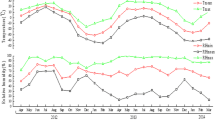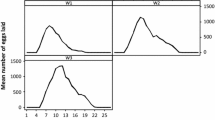Abstract
Seasonal abundance and activity of all the three post-embryogenic stages of Haemaphysalis longicornis, both feeding and free-living phases, were evaluated over a period of 2 years, from February 2008 to January 2010, in North China. Feeding ticks were removed weekly from head and ears of domestic sheep and the attachment sites of this tick were assessed coinstantaneously; free-living ticks were collected weekly in four habitat types by flag-dragging. The results suggested that H. longicornis mainly resides in shrubs and completes one generation per year with population attrition between stages. Infestation of nymphs was detected from March to September with highest peak between late April and early May; adults were detected from April to September with highest peak between late June and July, and an overwintering male population was found during late September to March; infestation of larvae was observed from June to October and peaked between middle August and early September. Most of this tick (91%) attached to head and ears of hosts. Additionally, we captured rodents from April to September 2008, but only a negligible number of nymphs were detected. This result suggested that rodents are not the principal hosts for this tick in the study area.





Similar content being viewed by others
References
Bai Q, Liu G, Han G (1996) Developing-morphological observations on Babesia ovata in engorged females Haemaphysalis longicornis and its eggs. Sci Agric Sin 29:89–92
Barnard DR, Morrison RD, Ervin T (1989) Sites of attachement and density assessment in Amblyomma americanum (Acari: Ixodidae) on nursing beef calves. Exp Appl Acarol 6:245–252
Chen W, Gao F (2000) Fauna Sinica, Mammalia, vol. 6 Rodentia. Science Press, Beijing
Estrada-Pena A, Jongejan F (1999) Ticks feeding on humans: a review of records on human-biting Ixodoidea with special reference to pathogen transmission. Exp Appl Acarol 23:685–715
Fourie LJ, van Zyl JM (1991) Interspecific variations in attachment sites and density assessment in female Ixodes rubicundus (Acari: lxodidae) on domestic and natural hosts. Exp Appl Acarol 13:1–10
Fourie LJ, Horak IG, van Zyl JM (1991) Sites of attachment and intraspecific infestation densities of the brown paralysis tick (Rhipicephalus punctatus) on Angora goats. Exp Appl Acarol 12:243–249
Frenot Y, De Oliveir E, Gauthier-clerc M, Deunff J, Bellido A, Vernon P (2001) Life cycle of the tick Ixodes uriae in penguin colonies: relationships with host breeding activity. Int J Parasitol 31:1040–1047
Fujisaki K, Kawazu S, Kamio T (1994) The taxonomy of the bovine Theileria spp. Parasitol Today 10:31–33
Guan G, Moreau E, Liu J, Hao X, Ma M, Luo J, Chauvin A, Yin H (2010) Babesia sp. BQ1 (Lintan): molecular evidence of experimental transmission to sheep by Haemaphysalis qinghaiensis and Haemaphysalis longicornis. Parasitol Int 59:265–267
Hoogstraal H, Roberts FHS, Kohls GM, Tipton VJ (1968) Review of Haemaphysalis (Kaiseriana) longicornis, Neumann (Resurrected) of Australia, New Zealand, New Caledonia, Fiji, Japan, Korea, and northeastern China and U.S.S.R. and its parthenogenetic and bisexual populations (Ixodoidea, Ixodidae). J Parasitol 54:1197–1213
Islam MK, Alim MA, Tsuji N, Mondal MMH (2006) An investigation into the distribution, host-preference and population density of Ixodid ticks affecting domestic animals in Bangladesh. Trop Anim Health Prod 38:485–490
Jongejan F, Uilenberg G (2004) The global importance of ticks. Parasitology 129(Suppl):S3–S14
Kaufman R (2010) Ticks: physiological aspects with implications for pathogen transmission. Ticks Tick-borne Dis 1:11–22
L’Hostis M, Diarra O, Seegers H (1994) Sites of attachment and density assessment of female Ixodes ricinus (Acari: Ixodidae) on dairy cows. Exp Appl Acarol 18:681–689
Labruna MB, Kasai N, Ferreira F, Faccini JLH, Gennari SM (2002) Seasonal dynamics of ticks (Acari: Ixodidae) on horses in the state of São Paulo, Brazil. Vet Parasitol 105:65–77
Latha BR, Aiyasami SS, Pattabiraman G, Sivaraman T, Rajavelu G (2004) Seasonal activity of ticks on small ruminants in Tamil Nadu State, India. Trop Anim Health Prod 36:123–133
Liu J, Jiang Z (1998) Studies on the bionomics of Haemaphysalis longicornis Neumann (Acari: Ixodidae) under laboratory conditions. Acta Entomol Sin 41(3):280–283
Matthee S, Meltzer DGA, Horak IG (1997) Sites of attachment and density assessment of ixodid ticks (Acari: Ixodidae) on impala (Aepyceros melampus). Exp Appl Acarol 21:179–192
Nelson WA, Keirans JE, Bell JF, Clifford CM (1975) Host-ectoparasite relationships. J Med Entomol 12:143–166
Ohta M, Kawazu S, Terada Y, Kamio T, Tsuji M, Fujisaki K (1996) Experimental transmission of Babesia ovata oshimensis n. var. of cattle in Japan by Haemaphysalis longicornis. J Vet Med Sci 58(11):1153–1155
Oliveira PR, Borges LMF, Lopes CML, Leite RC (2000) Population dynamics of the free living stages of Amblyomma cajennense (Fabricius, 1787) (Acari: Ixodidae) on pastures of Pedro Leopoldo, Minas Gerais state, Brazil. Vet Parasitol 92:295–301
Oorebeek M, Kleinorfer S (2008) Climate or host availability: what determines the seasonal abundance of ticks? Parasitol Res 103:871–875
Padgett K, Lane RS (2001) Life cycle of Ixodes pacificus (Acari: Ixodidae): timing of developmental processes under field and laboratory conditions. J Med Entomol 38:684–693
Sonenshine DE, Atwood EL, Lamb JT Jr (1966) The ecology of ticks transmitting Rocky Mountain spotted fever in a study area in Virginia. Ann Entomol Soc Am 59:1234–1262
Sonenshine DE, Lane RS, Nicholson WL (2002) Ticks (Ixodida). In: Mullen G, Durden L (eds) Medical and veterinary entomology. Academic Press, San Diego, pp 517–558
Teng K, Jiang Z (1991) Economic insect Fauna of China, Fasc 39, Acari: Ixodidae. Science Press, Beijing
Tenquisf JD, Charleston WAG (2001) A revision of the annotated checklist of ectoparasites of terrestrial mammals in New Zealand. J R Soc N Z 31(3):481–542
Tomassone L, Camicas JL, Pagani P, Diallo OT, Mannelli A, Meneghi DD (2004) Monthly dynamics of ticks (Acari: Ixodida) infesting N’Dama cattle in the Republic of Guinea. Exp Appl Acarol 32:209–218
Troughton DR, Levin ML (2007) Life cycles of seven ixodid tick species (Acari: Ixodidae) under standardized laboratory conditions. J Med Entomol 44:732–740
Zheng H, Yu Z, Chen Z, Zhou L, Zheng B, Ma H, Liu J (2011) Development and biological characteristics of Haemaphysalis longicornis (Acari: Ixodidae) under field conditions. Exp Appl Acarol 53:377–388
Acknowledgments
This project was supported by National Natural Science Foundation of China (30970406, 31071979) and Key Basic Research Foundation of Hebei Province, China (11965516D).
Author information
Authors and Affiliations
Corresponding author
Rights and permissions
About this article
Cite this article
Zheng, H., Yu, Z., Zhou, L. et al. Seasonal abundance and activity of the hard tick Haemaphysalis longicornis (Acari: Ixodidae) in North China. Exp Appl Acarol 56, 133–141 (2012). https://doi.org/10.1007/s10493-011-9505-x
Received:
Accepted:
Published:
Issue Date:
DOI: https://doi.org/10.1007/s10493-011-9505-x




